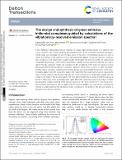Files in this item
The design and synthesis of green emissive iridium(III) complexes guided by calculations of the vibrationally-resolved emission spectra
Item metadata
| dc.contributor.author | Mackenzie, Campbell Frank Ross | |
| dc.contributor.author | Kwak, Seung-Yeon | |
| dc.contributor.author | Kim, Sungmin | |
| dc.contributor.author | Zysman-Colman, Eli | |
| dc.date.accessioned | 2023-03-08T14:30:02Z | |
| dc.date.available | 2023-03-08T14:30:02Z | |
| dc.date.issued | 2023-04-07 | |
| dc.identifier | 283549400 | |
| dc.identifier | a8fd7503-d175-421a-8855-c5c9f4fc91a7 | |
| dc.identifier | 85149849778 | |
| dc.identifier.citation | Mackenzie , C F R , Kwak , S-Y , Kim , S & Zysman-Colman , E 2023 , ' The design and synthesis of green emissive iridium(III) complexes guided by calculations of the vibrationally-resolved emission spectra ' , Dalton Transactions , vol. 52 , no. 13 , pp. 4112-4121 . https://doi.org/10.1039/D3DT00304C | en |
| dc.identifier.issn | 1477-9226 | |
| dc.identifier.other | ORCID: /0000-0001-7183-6022/work/130660101 | |
| dc.identifier.uri | https://hdl.handle.net/10023/27132 | |
| dc.description | Funding: The authors acknowledge Samsung for funding this research. | en |
| dc.description.abstract | A key challenge in developing emissive materials for organic light-emitting diodes is to optimize their colour saturation, which means targeting narrowband emitters. In this combined theoretical and experimental study, we investigate the use of heavy atoms in the form of trimethylsilyl groups as a tool to reduce the intensity of the vibrations in the 2-phenylpyridinato ligands of emissive iridium(III) complexes that contribute to the vibrationally coupled modes that broaden the emission profile. An underutilised computational technique, Frank-Condon vibrationally coupled electronic spectral modelling, was used to identify the key vibrational modes that contribute to the broadening of the emission spectra in known benchmark green-emitting iridium(III) complexes. Based on these results, a family of eight new green-emitting iridium complexes containing trimethylsilyl groups substituted at different positions of the cyclometalating ligands has been prepared to explore the impact that these substituents have on reducing the intensity of the vibrations and the resulting reduction in the contribution of vibrationally coupled emission modes to the shape of the emission spectra. We have demonstrated that locating a trimethylsilyl group at the N4 or N5 position of the 2-phenylpyridine ligand damps the vibrational modes of the iridium complex and provides a modest narrowing of the emission spectrum of 8-9 nm (or 350 cm-1). The strong correlation between experimental and calculated emission spectra highlights the utility of this computational method to understand how the vibrational modes contribute to the profile of the emission spectra in phosphorescent iridium(III) emitters. | |
| dc.format.extent | 10 | |
| dc.format.extent | 2011849 | |
| dc.language.iso | eng | |
| dc.relation.ispartof | Dalton Transactions | en |
| dc.subject | QD Chemistry | en |
| dc.subject | DAS | en |
| dc.subject | MCC | en |
| dc.subject.lcc | QD | en |
| dc.title | The design and synthesis of green emissive iridium(III) complexes guided by calculations of the vibrationally-resolved emission spectra | en |
| dc.type | Journal article | en |
| dc.contributor.institution | University of St Andrews. School of Chemistry | en |
| dc.contributor.institution | University of St Andrews. Centre for Energy Ethics | en |
| dc.contributor.institution | University of St Andrews. EaSTCHEM | en |
| dc.identifier.doi | https://doi.org/10.1039/D3DT00304C | |
| dc.description.status | Peer reviewed | en |
This item appears in the following Collection(s)
Items in the St Andrews Research Repository are protected by copyright, with all rights reserved, unless otherwise indicated.

